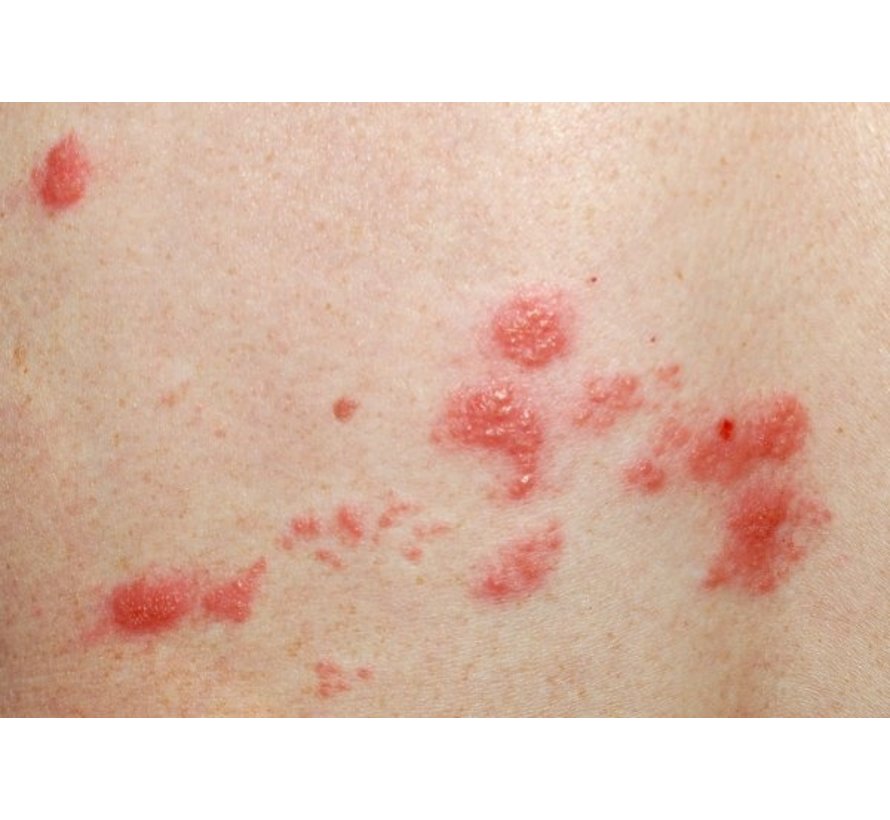Herpesvirus 6 (HHV-6) IgG The sixth disease
Herpes hominis virus type 6 (HHV-6)-IgG (code HHV-8GI serum)
Incubation periodThe
incubation period averages 10 days (5-15 days).
After primary infection, HHV-6, like other herpesviruses, remains latent without clinical consequences in various cells and organs such as in mononuclear cells, bone marrow, liver and lungs. In less than 1% of the general population the virus integrates into the telomeres of the chromosomes (ciHHV-6).(Arbuckle, Medveczky et al. 2010, Pellett, Ablashi et al. 2012, Clark 2016) In 1% of cases this is heritable (iciHHV-6), possible clinical consequences are being investigated but involve small numbers of rare diseases.(Komaroff, Phan et al. 2016)
The virus multiplies in salivary glands and is excreted in saliva and feces, with the number of virus particles varying depending on the condition of the carrier.(Agut, Bonnafous et al. 2015, Agut, Bonnafous et al. 2016)
Reactivation of HHV-6 occurs in immunocompromised patients due to immune deficiency or immunosuppression, (such as patients after bone marrow or organ transplantation, patients with HIV, or cancer patients undergoing chemotherapy).(Verhoeven, Claas et al. 2015, Munawwar and Singh 2016)
Certain drugs (such as carbamazepine, phenytoin, phenobarbital, zonisamide, allopurinol, salazosulfapyridine, diaphenylsulfone, and mexiletine) can also provoke reactivation of HHV-6 with symptoms such as fever, rash, leucocytosis, hepatitis, or renal failure (DRESS=Eng.: Drug Rash with Eosinophilia and Symptomatic Symptoms; drug exanthema with eosinophilia and symptomatic symptoms). This may also be confined to the skin (Pityriasis Rosea).(Agut, Bonnafous et al. 2016, Drago, Ciccarese et al. 2016)
HHV-6 is associated with a number of neurological diseases as a subtype of MS, Guillain-Barré, encephalitis and epilepsy.(Yao, Crawford et al. 2010, Mohammadpour Touserkani, Gainza-Lein et al. 2016) As an opportunistic infection, the virus is also detected in various organs like heart (Lautenschlager and Razonable 2012), liver (Hill, Myerson et al. 2014) and thyroid.(Chapenko, Roga et al. 2016) Here, it is not always clear whether it is a primo infection or a reactivation.
Natural immunityAfter
the primary infection, antibodies are formed that protect against re-infection. Going through an infection with HHV-6 does not give protection against HHV-7 and, in addition, HHV-7 can reactivate a latent HHV-6 infection. A second episode of exanthema subitum is rare. At age two, seroconversion has usually occurred after going through HHV-6, at age five or six after going through HHV-7.
Infectious periodIt
is unknown how long one is infectious in the acute phase. The period of excretion is 60-90 days. After this, the virus remains latent and the patient is potentially infectious for life.
InfectivityThe
extent of infectivity during the acute infection and during the latent phase that follows is unknown.
Diagnostics are only available in a few centers in the Netherlands. It is recommended that when requesting diagnostics, the physician-microbiologist be consulted in advance about the indication, test method and collection of samples.
Direct diagnosisA
primary infection or re-activation of HHV-6 is detectable by PCR.
Approximately 1% of the population in Europe and the USA has chromosomally integrated HHV-6 (ciHHV-6). In these individuals, a high HHV-6 DNA load is found with HHV-6-PCR on whole blood, but HHV-6-PCR on serum or plasma can also be strongly positive and falsely suggest active HHV-6 replication. It is therefore important to differentiate ciHHV-6 from an active HHV-6 viraemia. This can be done using rtPCR and by comparing the HHV-6-PCR signals on whole blood and on plasma. The prevalence of ciHHV-6 ranges from 0.2% in Japan and 0.6% in Canada to 1.0%-3.0% in Europe (Pellett et al. 2012; Clark 2016).
Indirect diagnosisFor
HHV-6, paired serology is possible (IgG titer rise; detection of IgM especially in primo infection). No serology is available in The Netherlands for HHV-7.
To request Herpes 6 IgM primo infection, contact us by email.




